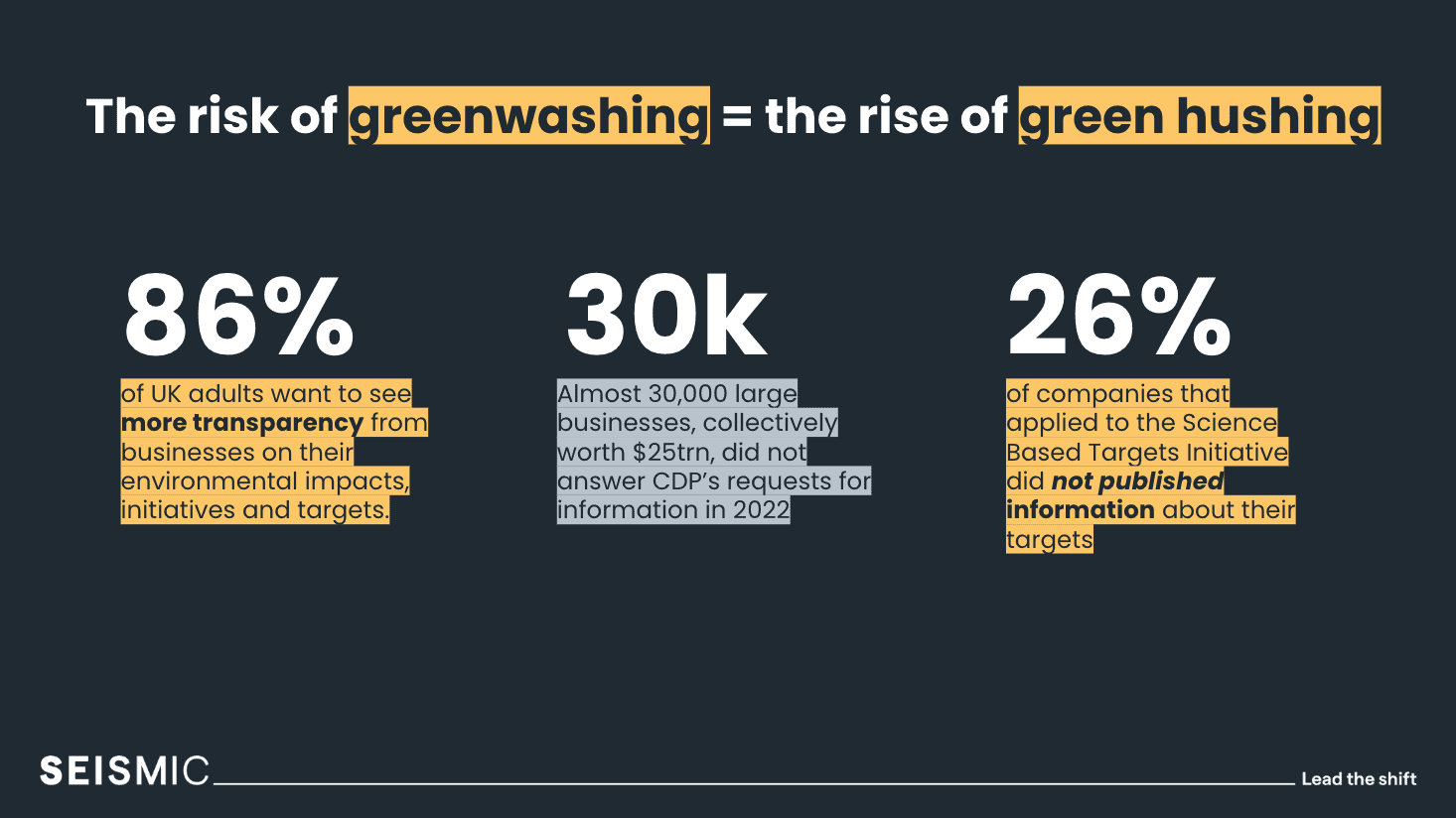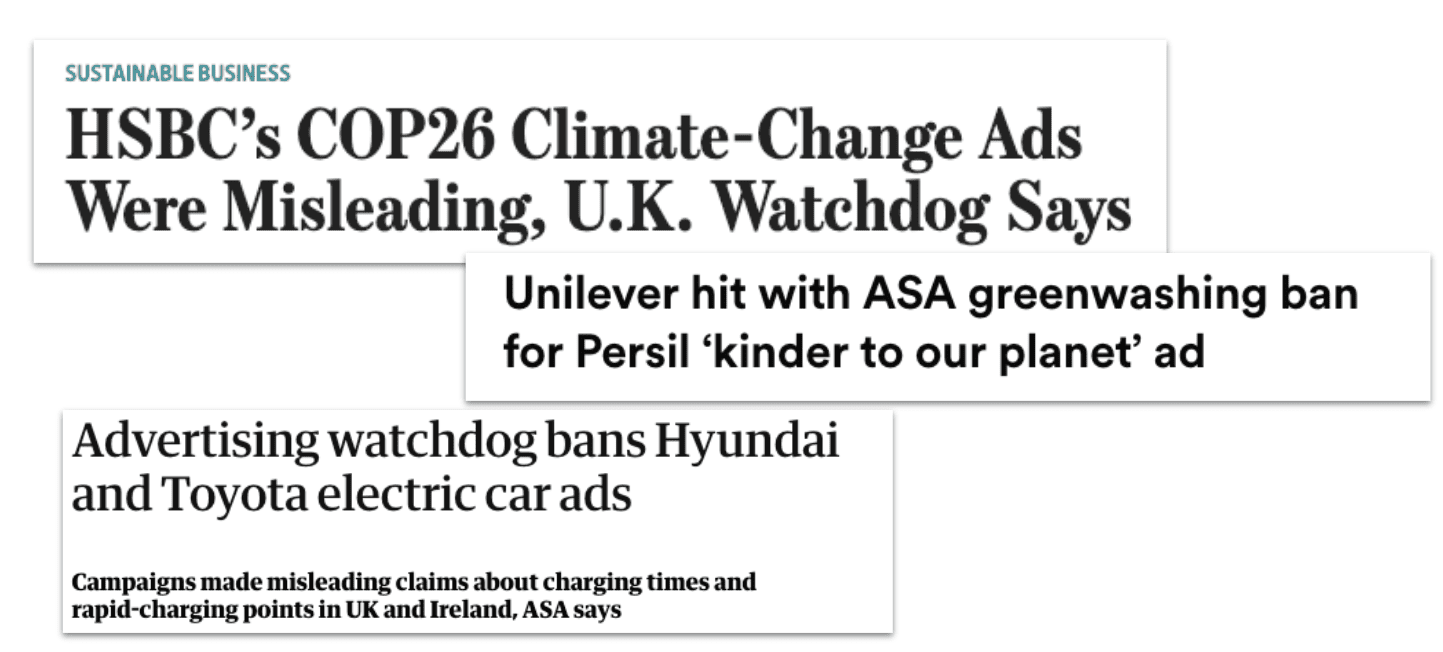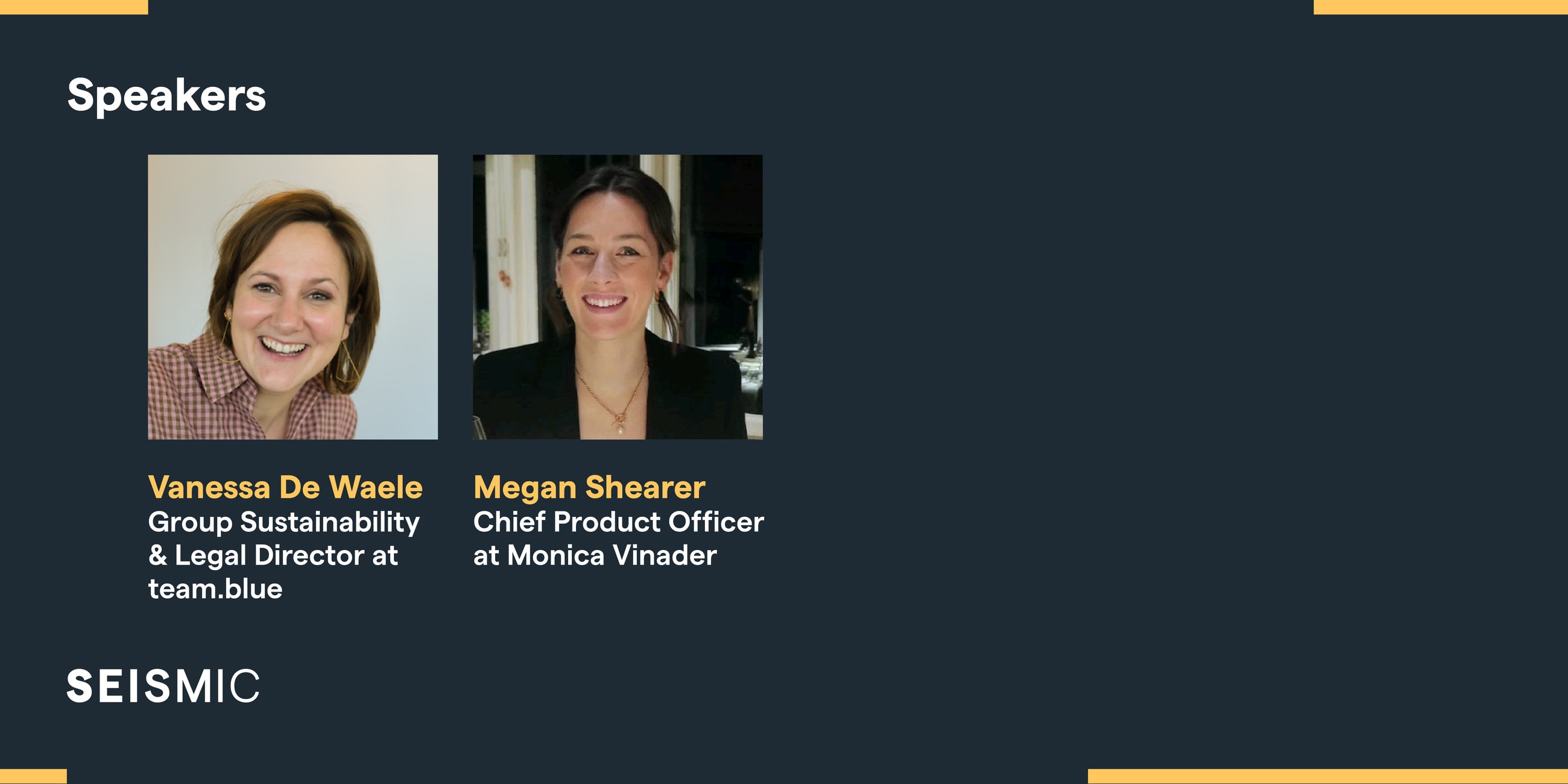
With increasing pressure from stakeholders to act on sustainability, it’s vital for businesses to communicate transparently and consistently on their impact. In our recent Breakfast Briefing, Seismic’s Head of Sustainability Communications, Olivia Hill, joined by sustainability leaders Vanessa De Waele, Group Sustainability & Legal Director at team.blue and Megan Shearer, Chief Product Officer at Monica Vinader, to discuss greenwashing, greenhushing and how to communicate your ESG journey authentically.
What is ‘greenwashing’?
The term ‘greenwashing’ comes from corporations making unsubstantiated sustainability claims to sell products and services without evidence, or deliberately concealing bad practices. While some claims arise from genuine belief or a focus on a singular aspect, the risk lies in overlooking holistic impact. Businesses can put themselves at risk when failing to consider the entire holistic aspect of a businesses sustainable and social impact.

The Greenwashing Landscape
With the rise in greenwashing, many companies fall to ‘greenhushing’, despite the public demand for transparency.
Greenhushing is when companies intentionally don’t talk about, or report on, any of their sustainability initiatives, out of fear of saying the wrong thing or slipping into greenwashing, due to a lack of understanding or confidence in their sustainability claims.
To remove the fear of greenwashing, whilst avoiding falling into the trap of greenhushing, businesses must consider what evidence is needed to back up their sustainability claims, and how to communicate their ESG journey with authenticity.

Understanding regulations
The Advertising Standards Authority has recently increased their guidance around misleading claims. The Competition and Markets Authority, who produced the Green Claims Code, which reflects the European Commission’s Green Claims Directive, also has new legislation in place. Companies, particularly marketing teams, need to know what is being asked of them.
“Claims based on future goals relating to reaching Net Zero or achieving carbon neutrality should be based on a verifiable strategy to deliver them.” – UK Advertising Standards Authority
How to avoid greenwashing
The benefits of B Corp are continually evolving, with employees, business owners and investors seeing the value in the framework and certification for the growth, impact and health of a business. Here are some reasons why so many businesses are getting on board:
- Honesty and Transparency – Sustainability is a journey; share where you are at, give equal exposure to your successes and your challenges.
- Evidence current status and future targets – Measure your sustainable and social impact. Set targets, stick to them and publicly share your progress.
- Verify your efforts and claims – Validate your efforts with a third-party impact partner. Use a framework and build an improvement action plan.
At Seismic, we believe that the B Corp framework is a crucial tool to help businesses confidently communicate their impact. The holistic analysis that is enabled by the B Impact Assessment (BIA), B Lab’s online assessment tool, covers five impact areas, providing thorough guidance to source evidence, measure impact and confidently communicate ESG progress.
Another easy win to adhere to authentic communications is to develop an Impact Report. Impact reports encourage best practice for sharing ESG progress with an established narrative, with a detailed focus on projects, goals and case studies, bringing your ESG goals to life. This forms a foundation for your sustainability communications, providing evidence, awareness and answers for stakeholders and governing bodies.
Greenwashing Do’s and Don’ts
Do:
- Think about language
- Measure your progress
- Commit to targets
- Share your challenges
- Consider stakeholders
- Embrace the journey
Don’t:
- Only talk about what you’ve done well
- Forget to consider all areas of business
- Publish anything that can’t be evidenced
- Overestimate
Opinions from two sustainability Leaders
Megan Shearer – Chief Product Officer at Monica Vinader. Monica Vinader is a British jewellery maker celebrating individuality, who is striving to make all elements of their business sustainable.
Vanessa De Waele – Group sustainability and legal director at team.blue. team.blue is a leading digital enabler for companies and entrepreneurs. They strive to make all areas of their global business sustainable, diverse and inclusive.

Monica Vinader’s Impact Journey and Approach
“Since day one we’ve followed a framework that has focused on our people, both our internal team and our customers. Our core value and mantra is to take a ‘customer-obsessed approach’. As a manufacturing company, we put a significant amount of effort into our supply chain, always seeking to raise the standards and drive transparency and traceability within our industry.”
Monica Vinader has used the B Corp framework to identify and focus their efforts on clearly defined goals, in order to continuously improve. They’re now communicating their efforts authentically, having just published their first Impact Report, on their progress to make sure they stand accountable and trusted by their stakeholders.
team.blue’s Impact Journey and Approach
“team.blue was founded in 2019 and has only been on its impact journey since March 2022. We were formed when three companies came together, and to answer the various questions we had about where we were on our sustainability journey, we focused in on the material aspects that are key to our business and the sector. We wanted to make progress, using data to find the key sustainability strategy.”
team.blue has already developed an environmentally friendly supply chain and prioritised the community through a robust digital presence, using innovations to challenge bigger players. Upon adopting the B Corp framework, they refined their ESG KPIs, facilitating effective communication with the board, stakeholders, and lenders.
Building on the five impact pillars of the BIA, their sustainability efforts have sparked enthusiasm across the wider businesses, increasing comprehension from other departments and encouraging support for sustainability practices.
Communicating ESG with authenticity
“We believe our customers shop with us for our designs, our brand and our affordable quality proposition. We know from consumer surveys that sustainability is important to some… but it’s certainly not the primary reason why customers shop with us. So we make sure we are communicating our sustainability messaging clearly, but that it’s not dominating. It can be a struggle to find the balance between clear comms and not overdoing it, but also trying to ensure that customers feel they can come to us as a responsible brand.” – Megan Shearer, Monica Vinader
To avoid greenwashing, Monica Vinader keep it simple, sticking to the facts by being as data-orientated as they can. They back up claims with evidence and verify them, acting as a responsible business by using the B Corp framework to validate all decisions.
The value of impact reporting for Monica Vinader has been strongest through leveraging their people and culture team, who are living and breathing their sustainability strategy on a daily basis. Growing traceability and transparency throughout the business and supply chain has helped with risk mitigation, which has led the business to take on a Risk manager, focusing on policy and ensuring that all ESG foundations are in place.
At team.blue, Vanessa De Waele advises businesses to obtain a senior board sponsor, who values sustainability. This is really helpful when securing budget for sustainability initiatives, and provides board-level buy-in throughout the ESG journey.
If you’re a private equity business you might have portfolio companies going through similar things and dealing with the same struggles, learn from them and share your experience to aid in building the strategy going forward. If you don’t have the resources in-house, reach out to whoever your community is and collaborate. It’s probably very important for them to show their investors what great things they’re doing too. Alongside the regular reporting use your community and strategise together.
Watch The Recording
If you missed the Breakfast Briefing, you can watch the recording below. Seismic’s monthly Breakfast Briefings aim to inform, educate and inspire our community. Sign up for our monthly newsletter to receive invites to upcoming events.
Your Communications Partner
We know outstanding communications and ESG performance are intrinsically linked to business success. Our team of communications experts guarantee purposeful storytelling without the risk of greenwashing, and we help bring your ESG strategy to life, engaging your employees, customers and investors in your impact journey. Speak to a Communications expert.


